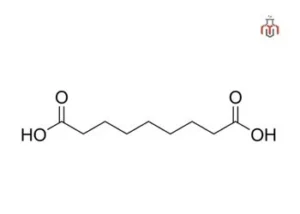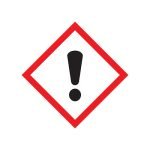
Azelaic acid is a naturally occurring saturated dicarboxylic acid, also known as nonanedioic acid, primarily found in the yeast Malassezia furfur (previously called Pityrosporum ovale). Industrially, it is produced through the ozonolysis of oleic acid. It exhibits both anti-inflammatory and antimicrobial activity, contributing to its broad dermatological applications.
Azelaic acid is widely recognized for its therapeutic efficacy in treating acne vulgaris, papulopustular rosacea, and other inflammatory skin conditions.

It works by inhibiting the acne-causing bacteria Propionibacterium acnes and Staphylococcus epidermidis, which infect skin pores. It also reduces the production of the enzymes tyrosinase and keratin, helping to lighten hyperpigmentation and melasma while preventing the formation of comedones (clogged pores).
CAS No.:123-99-9
Synonyms: Finacea; Anchoic acid; Azelex; Lepargylic acid; 1,7-Heptanedicarboxylic acid; Skinoren; 1,9-Nonanedioic acid
| Physical Properties | |
| Chemical formula | C9H16O4 |
| IUPAC Name | Nonanedioic acid |
| Molecular weight | 188.22 g/mol |
| Solubility | Soluble in hot water, alcohol, and organic solvents Slightly soluble in ethyl ether, benzene, DMSO |
| Density | 1.443 g/mL |
| Flash Point | 215 °C |
| Chemical Properties | |
| Color | White to off-white |
| State | Solid Crystalline powder |
| Melting point | 105-110 °C |
| Vapor Pressure | <1 mmHg at 20 °C |
| pKa | 4.550, 5.4985 |
| Loss on Drying | NMT 0.5 % |

| Pictograms : |  |
| Hazard Statements : | H315: Causes skin irritation H319: Causes serious eye irritation |
| Precautionary statements : | P264: Wash hands thoroughly after handling. P280: Wear protective gloves/protective clothing/eye protection/face protection/hearing protection. P302+P352: IF ON SKIN: wash with plenty of water P305+P351+P338: IF IN EYES: Rinse cautiously with water for several minutes. Remove contact lenses if present and easy to do – continue rinsing. P362: Take off contaminated clothing. |
Azelaic acid is a naturally occurring saturated dicarboxylic acid, also known as nonanedioic acid, primarily found in the yeast Malassezia furfur (previously called Pityrosporum ovale). Industrially, it is produced through the ozonolysis of oleic acid. It exhibits both anti-inflammatory and antimicrobial activity, contributing to its broad dermatological applications.
Azelaic acid is widely recognized for its therapeutic efficacy in treating acne vulgaris, papulopustular rosacea, and other inflammatory skin conditions.

It works by inhibiting the acne-causing bacteria Propionibacterium acnes and Staphylococcus epidermidis, which infect skin pores. It also reduces the production of the enzymes tyrosinase and keratin, helping to lighten hyperpigmentation and melasma while preventing the formation of comedones (clogged pores).
CAS No.:123-99-9
Synonyms: Finacea; Anchoic acid; Azelex; Lepargylic acid; 1,7-Heptanedicarboxylic acid; Skinoren; 1,9-Nonanedioic acid
| Physical Properties | |
| Chemical formula | C9H16O4 |
| IUPAC Name | Nonanedioic acid |
| Molecular weight | 188.22 g/mol |
| Solubility | Soluble in hot water, alcohol, and organic solvents Slightly soluble in ethyl ether, benzene, DMSO |
| Density | 1.443 g/mL |
| Flash Point | 215 °C |
| Chemical Properties | |
| Color | White to off-white |
| State | Solid Crystalline powder |
| Melting point | 105-110 °C |
| Vapor Pressure | <1 mmHg at 20 °C |
| pKa | 4.550, 5.4985 |
| Loss on Drying | NMT 0.5 % |

| Pictograms : |  |
| Hazard Statements : | H315: Causes skin irritation H319: Causes serious eye irritation |
| Precautionary statements : | P264: Wash hands thoroughly after handling. P280: Wear protective gloves/protective clothing/eye protection/face protection/hearing protection. P302+P352: IF ON SKIN: wash with plenty of water P305+P351+P338: IF IN EYES: Rinse cautiously with water for several minutes. Remove contact lenses if present and easy to do – continue rinsing. P362: Take off contaminated clothing. |
Azelaic acid shows initial improvement within a few weeks, and it will take almost 6 months to 12 months to show its visible improvements. However, its effects also depend upon the severity of the condition and the type of skin.
Azelaic acid helps to improve skin texture by promoting mild exfoliation, in the treatment of acne by killing the bacteria, and in reducing hyperpigmentation.
Azelaic acid is non-comedogenic; it helps in clearing existing blockages in pores and reduces inflammation.
Azelaic acid can be used in combination with retinol, these complementary ingredients can help address similar skin problems. Azelaic acid reduces hyperpigmentation while retinol supports the skin’s hydration and enhances collagen synthesis.
Azelaic acid is generally well-tolerated, but avoid combining it with high concentrations of exfoliating acids like glycolic acid and salicylic acid. These combinations can increase skin sensitivity and irritation.
Both azelaic and tretinoin are effective for treating acne and hyperpigmentation. For individuals with sensitive skin, azelaic acid may be a better starting option, whereas tretinoin may be preferred for more advanced skin concerns under supervision.